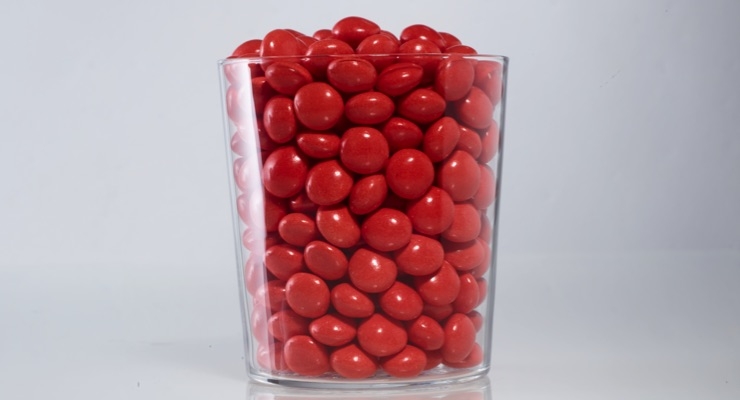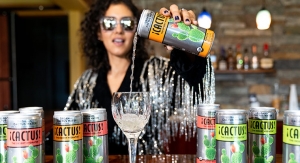07.12.18
Booth S4605
Lycored’s carotenoid-derived colors have passed the confectionery test, proving stable in both vitamin-enriched gummies and hard-coated candy.
Meanwhile, research has demonstrated that the use of natural colors does not diminish the appeal of candy to kids and enhances it for parents. All the research will be showcased at the forthcoming IFT Food Expo in Chicago, IL.
Lycored offers a range of natural color solutions for confectionery. Tomat-O-Red (pinks to reds) is sourced from lycopene from tomatoes, while Lyc-O-Beta (yellows and oranges) is extracted from beta-carotene.
First, researchers set out to test the performance of these carotenoid-derived colors in vitamin- enriched gummies. They carried out accelerated and real time shelf life stability tests on gummies colored with six different Lycored shades, comparing them with samples produced by the same manufacturer but colored artificially. The Lycored-colored gummies contained vitamin C, but the artificially colored alternatives did not.
The natural colors from Lycored all remained true to fruit in their natural color hues. Their stability was strong under intense light conditions and similar to that of the synthetic colors. This was the case despite the additional stress of vitamin C content, which disrupts the stability of some colorants.
Lycored also investigated the performance of its carotenoid-derived colors during the rigorous hard-coating/panning process in hard-coated confectionery.
They were tested in two different coatings for candy―Quick White from Norevo and Titanium Dioxide. The formulations, in shades of red, yellow and orange, were tested for four weeks at temperatures of 20°C, 25°C, 30°C, and 35°C in clear plastic bags and in a humidity-controlled environment.
Lycored’s colors all performed very well, achieving good quality shades in both coatings. In fact, the coating experts noted their user-friendliness compared to other color sources. Christof Ruttgers, confectionery technologist at D&F Drouven, which carried out the research, said: “Water-soluble reds can be challenging to work with in confectionery as they often become white or dusty when sugar crystals form. This is the case with synthetics and maltodextrin-based colors as well as vegetable concentrates such as beets. However, the Lycored colors we tested are oil-based, which makes them much more resilient.”
Natural Colors Not a Deal-Breaker for Kids
Lycored also undertook consumer research to understand the way children, and their parents, respond to natural and artificial colors in confectionery.
It conducted interviews with 10 children and their parents. Each pair was sent a bag of gummies colored naturally with Tomat-O-Red and Lyc-O-Beta and another made by the same manufacturer but colored artificially.
Both the children and their parents were able to distinguish between the naturally colored candies and the artificial ones. However, although the children tended to prefer the brighter, artificial colors they were enthusiastic about eating all of them.
The parents said that in an ideal world they would prefer to feed their kids healthy options. If all other factors, such as taste, were similar they would buy candy colored naturally. Some said they would be willing to pay more for naturally colored versions of candy they already buy.
Christiane Lippert, head of marketing, food, at Lycored, said: “For kids, candy is candy and taste is king. They might notice that artificially colored products look brighter, but color definitely isn’t a deal-breaker. And when their parents realize that naturally colored products taste exactly the same, factors like clean label and naturality come back into play. Meanwhile, we’re delighted that two more stability trials have demonstrated the high performance of our natural colors in yet another category.”
Lycored’s carotenoid-derived colors have passed the confectionery test, proving stable in both vitamin-enriched gummies and hard-coated candy.
Meanwhile, research has demonstrated that the use of natural colors does not diminish the appeal of candy to kids and enhances it for parents. All the research will be showcased at the forthcoming IFT Food Expo in Chicago, IL.
Lycored offers a range of natural color solutions for confectionery. Tomat-O-Red (pinks to reds) is sourced from lycopene from tomatoes, while Lyc-O-Beta (yellows and oranges) is extracted from beta-carotene.
First, researchers set out to test the performance of these carotenoid-derived colors in vitamin- enriched gummies. They carried out accelerated and real time shelf life stability tests on gummies colored with six different Lycored shades, comparing them with samples produced by the same manufacturer but colored artificially. The Lycored-colored gummies contained vitamin C, but the artificially colored alternatives did not.
The natural colors from Lycored all remained true to fruit in their natural color hues. Their stability was strong under intense light conditions and similar to that of the synthetic colors. This was the case despite the additional stress of vitamin C content, which disrupts the stability of some colorants.
Lycored also investigated the performance of its carotenoid-derived colors during the rigorous hard-coating/panning process in hard-coated confectionery.
They were tested in two different coatings for candy―Quick White from Norevo and Titanium Dioxide. The formulations, in shades of red, yellow and orange, were tested for four weeks at temperatures of 20°C, 25°C, 30°C, and 35°C in clear plastic bags and in a humidity-controlled environment.
Lycored’s colors all performed very well, achieving good quality shades in both coatings. In fact, the coating experts noted their user-friendliness compared to other color sources. Christof Ruttgers, confectionery technologist at D&F Drouven, which carried out the research, said: “Water-soluble reds can be challenging to work with in confectionery as they often become white or dusty when sugar crystals form. This is the case with synthetics and maltodextrin-based colors as well as vegetable concentrates such as beets. However, the Lycored colors we tested are oil-based, which makes them much more resilient.”
Natural Colors Not a Deal-Breaker for Kids
Lycored also undertook consumer research to understand the way children, and their parents, respond to natural and artificial colors in confectionery.
It conducted interviews with 10 children and their parents. Each pair was sent a bag of gummies colored naturally with Tomat-O-Red and Lyc-O-Beta and another made by the same manufacturer but colored artificially.
Both the children and their parents were able to distinguish between the naturally colored candies and the artificial ones. However, although the children tended to prefer the brighter, artificial colors they were enthusiastic about eating all of them.
The parents said that in an ideal world they would prefer to feed their kids healthy options. If all other factors, such as taste, were similar they would buy candy colored naturally. Some said they would be willing to pay more for naturally colored versions of candy they already buy.
Christiane Lippert, head of marketing, food, at Lycored, said: “For kids, candy is candy and taste is king. They might notice that artificially colored products look brighter, but color definitely isn’t a deal-breaker. And when their parents realize that naturally colored products taste exactly the same, factors like clean label and naturality come back into play. Meanwhile, we’re delighted that two more stability trials have demonstrated the high performance of our natural colors in yet another category.”



























